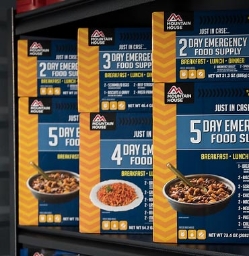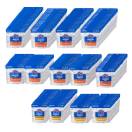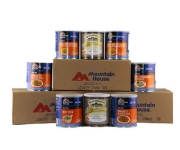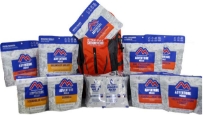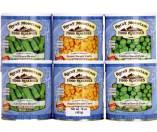MRE vs Freeze-Dried Meals, What’s the Difference?
Posted by Nitro-Pak on Mar 23rd 2020
MRE vs Freeze-Dried Meals, What’s the Difference?
By Aaron Curley and Harry Weyandt
When you hear the term “MRE”, most people usually think of food storage, camping foods or foods that our military uses in the field. Many mistakenly think that freeze-dried foods and MRE’s are nearly the same, which they are not. Let’s take a closer look…
MRE stands for Meals-Ready-to-Eat (“MRE”s). They were developed by the U.S. Military as a combat ration containing a full three-course meal for troops in the field. The main entrée is a wet pack, shelf-stable food product that is much like canned foods you buy in a grocery store except they are packaged in a “flexible foil pouch” and have a longer shelf-life. The entree is fully cooked and can be eaten hot or cold anytime, anywhere. No further preparation is required. Because full MRE meals usually contain a 3 course meal, they are easy to hand out and dispense in the field or in an emergency. They are also a great choice for adding to home bug-out bags.
Some MRE’s come with flameless water activated heater rations. These simply require a small amount of water to be poured into the pouch to set off a chemical reaction with the inner heater packet to provide you with a piping hot MRE entrée in about 10 minutes. The addition of these heater packets typically adds about a dollar per meal, or $12 to a case of 12 meals.
The design of the MRE’s multi-layered foil seal pouch can be heated or warmed in other ways also such as placing the pouch on a car dash board, on a hot engine block or placed on a rock in direct sun. This is one reason why they are a favorite among hunters and outdoor enthusiast because of their ease of use, carrying and compactness. MRE’s generally have about a five year shelf-life from date of manufacture when stored at about 70 degrees or less.
Buying MRE’s: First, find a reputable place to buy them from. All military MRE entrees and side dishes are made for the government under massive contracts. After a holding for a period time by the manufactures, production overruns are sold on the commercially market. These are typically 6 – 12 months old when they become available. In the industry, these are considered “fresh”.
Because the variety of entrée and side dishes are constantly changing with each contract, try finding a MRE seller that offers a wide range of entrée choices per case, 12 different meals is most preferable, though most companies offer only 3 to 4 varieties per case.
If you see MRE’s on bargain sites like Ebay or Amazon, beware that surplus sellers often dump their expired old stock on unsuspecting buyers who are not armed with this information here and do not know the right questions to ask. These MRE’s often seem like great bargains at $35-$60 per case of 12, but buyer beware. These can often be upwards to four years old with little shelf-life remaining. Know the manufacture dates before you buy so you get the longest shelf-life possible.
Secondly, don’t buy on price alone, cheaper does not mean it’s a better deal. Look closely at the average calories that the meals provide (many companies conceal this and say nothing hoping you will not ask) and look at the meal choices and other side components that are included. A normal contract military MRE meal contains a main entrée, side dish, bread item, dessert, beverage drink, and spoon and compliment accessories. These typically provide 1200 to 1500 calories per meal. The actually MRE’s sold to the U.S. government are not sold to the general public. All commercially made MRE’s are usually made of both military and commercially made parts and pieces to keep the prices more affordable, but compare the individual components carefully to know if it is a deal or rip-off.
MRE’s are perfect for quick meals with no preparation and you can eat them hot or cold. They are a great addition to any short term emergency plans for your home or business. Their disadvantage is their shorter 4-5 year shelf-life which takes them out of the running for long term storage plans. For extended food storage, we recommend looking closely at freeze-dried foods.
Freeze-Dried Foods and Meals
In comparison, freeze-Dried foods have up to 99% of their moisture or water removed through a process of sublimation, or freeze-drying as most people call it. This is done through a process where the foods are prepared, seasoned and cooked then flash frozen. Next, the foods are placed inside a freeze-drying chamber where a vacuum is pulled and the chamber slowly warmed to remove nearly 100% of the moisture from the foods. This whole process can take from 24 to 48 hours to complete, but the end result is well worth it.
Most people like freeze-dried foods because they simply taste better, much like frozen corn is preferred over canned corn. In addition, the end result is that they are super light-weight, retain their same shape, texture and flavor. These foods reconstitute fast in about 5-10 minutes by just adding hot water (cold can even be used in a pinch). No other dry food storage is faster to prepare or stores longer.
In addition, and perhaps most importantly, freeze-dried foods, because of the freeze-drying process, have the longest PROVEN shelf-life of all long-term storage foods. Mountain House® says that their freeze-dried foods packaged in metal cans or foil sealed pouches will store safely for 30 years when properly stored. They are the only company that offers a full line of real freeze-dried meals. Most of their meals are also made with real meats and not soy TVP, in both metal cans and foil pouches. They offer a wide variety to choose from such as beef stroganoff, lasagna, chili mac, beef stew and chicken teriyaki just to name a few.
It should be noted here that the name “freeze-dried food” does not always mean that the foods are really freeze-dried. Some food storage manufactures make survival foods and call their powdered soup based blends that are sprinkled with a few freeze-dried vegetables or meats as “freeze-dried”. These are not really freeze-dried meals. Dry powdered mix blends cost much less to make than real freeze-dried entrée meals and will not store as long. Only Mountain House® brand prepares, cooks and packages their own real freeze-dried meals.
Freeze-dried meals have been a top choice for campers, backpackers and preppers for over 40 years. If you have a stove and some water, they are the perfect choice for any camping adventure or emergency food storage plan.
When looking at the differences between MRE’s and Freeze Dried foods, they both have pros and cons which should be considered before purchasing. MRE’s are a great choice for immediate short-term emergencies when you need to bug-out fast but have a much shorter 4-5 year shelf-life. On the other hand, freeze-dried foods cannot be beat for both short and long term emergencies for a wider selection of meal choices, storage compactness and ultra-long 30 year shelf-life.
We recommend having a combination of both. MRE’s for 1-2 weeks for providing instant meals and freeze-dried foods for anything longer. Whatever you decide, just do something now while it is still fresh on your mind. As always, Have a Plan, Be Ready and Be Prepared!
